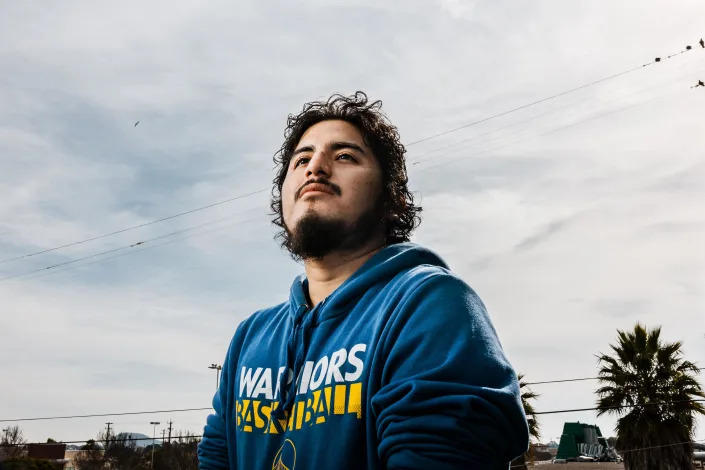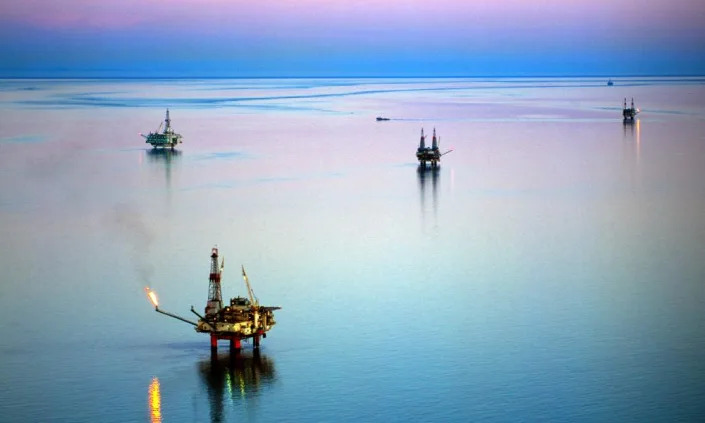
Abené Clayton in Los Angeles
Wed, February 8, 2023
Guns are now the No 1 killer of children and teens under 18 in the US, according to data from the US Centers for Disease Control and Prevention that was analyzed by University of Michigan researchers.
While 2020 marked the first year that more children and teens of all races and ethnicities across the US were killed by guns than in car accidents, homicide has been the No 1 cause of death among Black teenage boys and young adults over 15 for at least a decade, according to CDC data, and the second leading cause of death among Hispanic teenage boys and men ages 15 to 34. The trend was underscored by the recent high-profile killings of an 18-year-old at a gas station in Oakland, California, and two boys, ages 14 and 15, at a high school in Des Moines, Iowa.
Despite bearing much of the weight of the nation’s gun violence, young people have little formal power to do anything about it, since decisions about how governments legislate guns and how communities and schools respond to shootings is primarily left to lawmakers, voters and law enforcement officials.
Related: ‘Took a long time to get here’: the women stopping gun violence in their communities
Still, violence prevention and getting resources to communities is a top-of-mind issue for US teens and young adults. In an open letter the youth voting advocacy group NextGen America sent Joe Biden ahead of this week’s State of the Union address, the young people implored him and Congress to address lax state gun laws and racial disparities among homicide victims and gunshot wound survivors. A majority of Gen Z is more worried about guns than the climate crisis, according to a recent survey by Project Unloaded, while 70% of young voters said that US gun control laws should be stricter, according to a 2018 Harvard Institute of Politics poll.
“Politicians should be more involved in the community,” said Greg Novelo, a 20-year-old resident of Richmond, California, a small city north of San Francisco. “There’s no progress to show that they’re helping the community … they need activities, programs, parks you can go to that are safe.”
The Guardian spoke with Novelo and several other young Latino and Black Californians about what they want to see older generations do to prevent gun violence and to help youth navigate the aftermath of shootings.
Conversations about school safety must include neighborhood violence
Mass shootings on school campuses, while rare, dominate conversations about student safety. This means that most of the solutions put forth - like arming teachers, hiring more campus police and monitoring student communications - rarely address the shootings that happen near schools and on the blocks that students traverse to get there.
“When they have these conversations it’s more about gun violence at school and police using guns, not what goes on around the neighborhood,” said Liz Nsilu, a 17-year-old student at King/Drew Magnet school in Los Angeles. The school is just outside Watts, a majority Black and Latino neighborhood where residents have long struggled to keep shootings down and support those affected.
“I would like to hear someone ask how we feel living in the neighborhoods that we live in or having our school where it is now. I think teachers and the principal [should have] a school-wide conversation,” said Ilicia Mendez, another 17-year-old King/Drew student.
Nsilu and Mendez have a space to talk about shootings and gender-based violence that affect them through the Women’s Leadership Project (WLP), a group that works in South Los Angeles schools to mentor and support students.
Local violence prevention and youth development groups like WLP seek out students who are regularly exposed to violence to help them work through their feelings on off- campus shootings. And teachers across the US are working to make conversations about gun violence a part of classroom curricula. Still, these programs are sparse.
“The schools sometimes do their part,” said Tereek Hill, a 21-year-old Richmond resident.
When he was in high school, a student was shot and killed and administrators organized a campus-wide moment of silence and allowed students to leave class to decompress in the student health center, Hill recalled.
He didn’t feel safe at school because he knew that community violence can spill on to school grounds, especially since some students carried guns because they felt unsafe walking in their neighborhood. “If my friend just got killed, I’d think I’m next,” Hill said.
He wishes that schools could find a balance between keeping students safe and not criminalizing those who carry because they rightly feel unsafe in their communities. Strategies like backpack searches and arresting students aren’t the answer, he said: “We don’t want to go backward.”
Intergenerational connections help - if they come without judgment
The connections between older and younger generations can be a central component of gun violence prevention. Whether it’s a teacher, school counselor or a professional violence intervention worker, the students the Guardian spoke with said they looked to the adults in their lives and communities to lobby officials and help young people navigate the complex emotions that come with being exposed to gun violence.
But youth also want to see adults be more inclusive in their engagement with young people, including those who are already carrying guns, have been incarcerated or are in need of immediate intervention that can stop them from being shot or shooting someone else.
“They are at the most risk, so why exclude them? You can change them,” Beverly Obed, a 15-year-old King/Drew student, said of the need for programs that reach her most at-risk peers. “Excluding them might lead them further down the drain, stuck in [a bad] situation because they can’t get out because they’ve been excluded when they tried to reach out.”
Novelo, 20, of Richmond, has first-hand experience of this exclusion and the consequences of having nowhere to turn.
“I grew up hearing gunshots every day,” he said. “As a little kid, I needed more people to talk to and listen without [fear of] getting in trouble.”
Novelo began carrying a gun for protection as a young teen. When he would speak with school staff or other adults, he said, the fact that he carried and would skip school overshadowed the fear and daily trauma he was facing and needed help addressing.
“School counselors would offer support or resources, but when you talk to them they find fault [with me] and say, ‘Oh, you shouldn’t have done this or that,’” Novelo said. “It made me feel like I needed to keep everything to myself and bottle it up, and it messes with your head a little. There’s so much emotion and sometimes it’s tough to handle, and when you don’t have someone to talk to you end up doing [negative] things.”
He dropped out of high school during his junior year and months later, at age 18, he was shot eight times while hanging out with friends in San Pablo, a city just outside of Richmond. While in the hospital, he connected with Ryse Center, a Richmond-based violence prevention and youth development non-profit. Now, he said, he is getting the judgment-free mental health support he needed early in his adolescence.
“Older people should think about what programs would have helped them back then … and what they went through to help the community,” Novelo said.
Law enforcement isn’t always the solution
For many students in South Los Angeles and the Bay Area, police are a questionable solution to the problem of gun violence. They described seeing police use force in their communities, which are disproportionately harmed by gun violence, rather than helping people find solutions to young people being involved in gangs and gun violence.
When a shooting happens near or on a campus, administrators and lawmakers often defer to police to keep students and staff secure and safe. But this reliance on police has also led to a disproportionate number of Black and students being arrested on campus, thus fueling the school-to-prison pipeline, parents and students have said.
“That upsets me the most: the police using their force on us, taking advantage of their position because of what’s going on in our communities with gang violence,” said Mendez, of King/Drew.
The on-campus dynamic coupled with the history of police shootings of unarmed Black and Latino people make it difficult for the students to imagine what role law enforcement would play in local violence interventions like healing circles and community meetings among people who have lost a loved one to violence or survived being shot.
Related: A shooting killed their student. Now two California teachers are educating kids about gun violence
“It wouldn’t be effective for police to be in a healing circle because a lot of people in Los Angeles have trauma, from being shot by the police, chased by the police,” Nsilu added.
This lack of trust means that creating solutions to prevent and respond to gun violence is a job best left to the community members who deal with the fallout of shootings, Hill said.
“I’m not comfortable with [police] at all. The only help I see from them is escorting people during a funeral,” he said of how he’s seen police engage with those who have been affected by gun violence. “The community around us is responsible, the community should hold each other accountable.”
Youth need more resources to heal from gun violence
Jason Madison’s first confrontation with gun violence happened early in life. When he was nine, Madison’s mother and toddler nephew were shot in a drive-by in their hometown of Richmond. Both survived the shooting, which Madison witnessed; his mother was hit in the thigh and his then-two year old nephew was shot in the foot and was briefly in critical condition.
Madison, now 22, wasn’t physically injured in the shooting, but says he was left to deal with mental trauma and unanswered questions alone.
“Seeing someone get shot even though they didn’t die is still trauma,” he said. “I dealt with it alone and I wish I had support … I needed somebody to talk to and relate to and help me through the pain and trauma I went through.”
Through Ryse Center, Madison has been working through his trauma through poetry and counseling sessions. And while he is grateful to have these resources now, he wishes that it hadn’t taken most of his life to get them. He also wants more organizations like Ryse to expand their reach to capture those who have been harmed by gun violence, directly and indirectly.
“As soon as my mom and nephew got shot, I feel like somebody - the ambulance people or police - should have put us in some type of counseling,” Madison said. “The kids need help. We go through a lot. We go through so much in our life. We need more resources.”

























